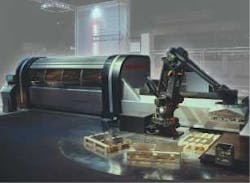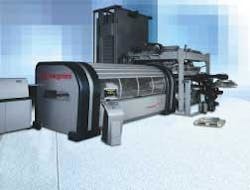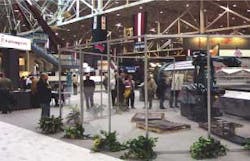Robots tow the load
Competition is intense. In a world where technology is advancing rapidly, companies that can predict and address needs quickly and accurately will ultimately stand the best chance of thriving in tough economic climates and souring during times of growth. In the world of sheet metal fabrication—a field that typically feels the trend sooner and takes longer to recover than other markets—flexibility and reliability are paramount in achieving success. The applied concepts of lean manufacturing and true flexible manufacturing solutions (FMS) advance the causes of reduced lead times and cost reduction.
In implementing true FMS, the systems put in place to manufacture and generate production today must be adaptive and able to strategically morph to a new configuration as product needs alter. This is the competitive edge that will fuel the fire of success now and in the future for true FMS.
In the wake of rapid advancement, it is often the overlooked or troublesome challenges that ultimately stand to reap a sizeable reward. Reducing any process that does not add value to the end product is the hallmark of lean manufacturing. No doubt the laser has proven itself a contender and champion in the world of metal fabrication, but can it be taken a step further? The answer is yes if automated handling of laser cut blanks continues to make strides.
Laser cutting systems have been stragglers in the migration to full automation and material handling. True integrated automation has commonly been left out of the development phases of laser processing centers until, in an after thought, the automation is applied to an existing design. The priority of automation is secondary, thus reducing or eliminating the effective blend into true FMS and true one-piece flow operations.
The troubled past of automated laser cutting has caused the omission of laser processing from true FMS. Laser systems have been able to achieve 'simulated' FMS, but frequently sheets processed in automated cycles still require human intervention to pull and separate the parts from the material skeleton. This 'interruption' of the automated process results in a non-value add function and with it come also the safety risks and opportunity for error, which are the result of such practices. The reduction and ultimately the elimination of such interruptions must be the goal to introduce laser technology to the vision of true FMS.
A new chapter of automation has emerged to place automated material handling after the laser processed sheets. A phase of automation that begins at raw sheet or coil stock is laser processed, formed, and ultimately emerges as finished product. The magic in the middle is the 'stuff' worth talking about.
Robotized unloading or sorting of laser cut parts, delivered to pallets or conveyors, and passed to forming centers is the heart of this new phase. The stronghold restricting true automation lies in the separation of the laser processed parts from the skeleton as well as the internal scrap generated within the part profile. By eliminating this stronghold, the full potential of laser processing will be achieved.
The strongest ally in this quest is intelligent software.
Advanced software developed to take full advantage of the collective experiences in material processing—software that places strategies and preventative measures in line to predict and maintain control of the laser process—will define the success of automated systems. It is the ability to create intelligent systems via the software manipulation that ensures productive advancements in FMS.
Sophisticated unloading software is key to successful and productive laser part retrieval. The system must be intelligent enough to determine the freed laser part from the scrap region and send the coordinates for retrieval to ensure accurate robotic unloading. The scrap or skeleton generated in laser processing can pose a great challenge to successful unloading. Software coupled with a cutting system that manages this obstacle is a prerequisite for implementing this phase of truly flexible automation. The result, laser cut parts extracted from the sheet and deposited on pallets, within containers, on conveyors, or hung on paint lines, makes the investment well worth the effort.
Intelligent software that calculates and assigns robotic pickup location 'on-the-fly' or straight from the CAD information eliminates the need for costly 'teaching' time. The critical balance between cutting time and unloading time must be orchestrated in such a manner that the laser system is never waiting or starving for material. The continuing force to increase productivity while minimizing cost challenges software packages to bear the burden and deliver the solutions necessary to meet elevated goals. In addition, with robotic pickup assignment being determined 'on-the-fly' or automatically, the part batch levels can become smaller and systems are more effective when responding to dynamic production fluctuations.
The 'end effector' or gripping device of a robotic unloading unit must be able to use a level of intelligence when retrieving and placing a piece. A gripping device can incorporate magnets when processing ferrous materials or suction cups when nonferrous materials are processed. A combination of the two can be applied to manage dynamic production where both material types are strategically placed within the picking head. In addition, the sole use of magnets for ferrous part retrieval is challenging, as magnetic dust is a byproduct of laser processing and interferes with reliable performance of magnets. The placement and sensitivity of the cups play a large role in the confirmation of part versus scrap selection. Determining the best placement of the gripping device with respect to the skeleton is key when applying intelligent selection to a process which, at it's core, is continually stress relieving most of the materials being processed.
The thermal nature of laser material processing introduces an array of challenges to part manipulation and part identification. High-speed laser processing enables the systems to destroy internal scrap and free the surrounding part profile skeletons, thus 'freeing' the laser cut piece for retrieval by the robot. Advancements in intelligent software as well as developing expertise in laser part manipulation stand to place lasers as an established contender in the search for true flexible manufacturing solutions.
The technology of laser cutting has well been established as an accepted and matured process. The quantum leap in processing speeds experienced in the dawn of high-speed laser cutters took laser processing to a whole new level of acceptance. In the light gauge market, the consensus, "you will never cut a whole as fast as you can punch it" can now be retired to the Metal Fabrication Hall of Fame of "used to be true" slogans. The ever-increasing strides in integrated automation and part manipulation will allow the laser to be introduced to the fold.
The robotized separation of laser parts will ensure that seamless integration between the laser and forming fabrication is automated, and thus lend the advantage of full automation to overall increased productivity. Large system OEMs and automated job shops alike will benefit from the ability to distinguish and deliver laser parts to automated forming centers. In the end, robotized part selection may migrate to a proven technology and a successful element in the continuing vision of true FMS, thus making laser processing the the crowning jewel of automation.
Elizabeth Kautzmann is product manager laser technologies at Salvagnini America Inc. (Hamilton, OH), www.salvagnini.com.



